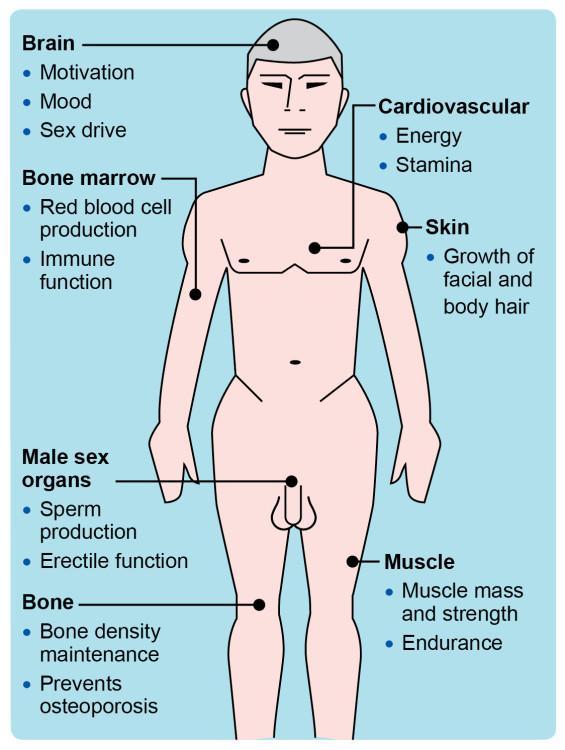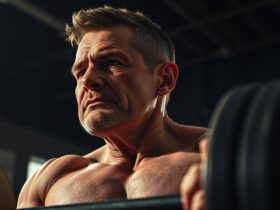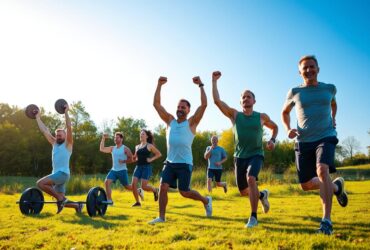In the world of fitness and athletic performance, the pursuit of optimal recovery is a quest that never ceases. After intense workouts, athletes and fitness enthusiasts alike often turn to various methods to restore their bodies and enhance muscle recovery. Amidst this myriad of strategies, testosterone therapy has emerged as a focal point of discussion, sparking interest and curiosity. Known primarily for its role in building muscle and enhancing energy levels, testosterone’s potential impact on recovery is worth exploring. This article delves into the science behind testosterone therapy, examining its benefits, risks, and the evidence supporting its role in muscle recovery. As we navigate the complexities of hormonal health and recovery, we’ll shed light on whether this controversial therapy could be a game-changer for those seeking to optimize their physical performance.
Understanding Testosterone Therapy and Its Role in Muscle Recovery
Testosterone therapy has emerged as a significant strategy for enhancing muscle recovery, particularly for individuals engaged in intense physical training. This therapy involves the administration of testosterone through various methods, such as injections, patches, or gels, aiming to restore optimal hormone levels in the body. As testosterone plays a critical role in protein synthesis, which is essential for muscle growth and repair, many athletes and fitness enthusiasts have begun to explore its benefits. Key benefits of testosterone therapy include:
- Increased Muscle Mass: Elevated testosterone levels can lead to increased muscle hypertrophy.
- Improved Recovery Time: Faster recovery from strenuous workouts reduces downtime between training sessions.
- Enhanced Strength: Boosted testosterone correlates with greater strength gains, essential for athletes.
However, it is crucial to approach testosterone therapy with caution and under medical supervision. Not everyone may require hormonal intervention, and misuse can lead to adverse effects. The ideal candidates for this therapy typically exhibit symptoms of testosterone deficiency, such as decreased energy, diminished libido, and reduced muscle mass. To determine the appropriateness of therapy, clinicians often rely on comprehensive assessments, including hormone level testing and evaluation of overall health. Considerations before starting therapy include:
| Factor | Consideration |
|---|---|
| Age | Older individuals may naturally have lower testosterone levels. |
| Health Status | Pre-existing health conditions can affect therapy outcomes. |
| Goals | Clearly defined fitness goals help guide therapy use. |

The Science Behind Testosterone: How It Facilitates Muscle Growth and Repair
Testosterone, a steroid hormone primarily produced in the testes and ovaries, plays a crucial role in muscle physiology. It acts at various levels to promote muscle growth and repair. The hormone enhances protein synthesis, which is the process through which cells build proteins, essential for muscle recovery. By binding to androgen receptors on muscle cells, testosterone stimulates the activation of satellite cells, facilitating muscle regeneration after intense exercise. Additionally, it influences the production of growth factors, which are vital for muscle hypertrophy and overall tissue repair.
The relationship between testosterone and muscle health can be highlighted through several key mechanisms:
- Increased Muscle Mass: Elevated testosterone levels contribute to a larger cross-sectional area of muscle fibers.
- Enhanced Recovery: The hormone accelerates recovery times post-exercise by reducing muscle damage.
- Fat Loss: Testosterone aids in reducing fat mass, further enhancing muscle definition and performance.
- Boost in Strength: Higher testosterone levels are linked to increased strength output during resistance training.
To draw a clearer perspective on testosterone’s role, consider the following comparison:
| Factor | Low Testosterone | Normal Testosterone |
|---|---|---|
| Muscle Mass | Decreased | Increased |
| Recovery Time | Prolonged | Reduced |
| Fat Distribution | Higher Fat Mass | Better Distribution |
| Strength Levels | Weaker | Stronger |
Understanding these dynamics is essential for those exploring testosterone therapy as a means to enhance muscle recovery and performance. The implications of testosterone on athletic performance are profound, and for individuals experiencing low testosterone levels, therapy may present a viable pathway towards improving muscle recovery and achieving fitness goals.

Identifying Candidates for Testosterone Therapy: Who Can Benefit the Most
When considering testosterone therapy, it is essential to identify individuals who stand to gain the most benefits. Candidates typically include those who exhibit signs of low testosterone levels, which may manifest as decreased energy, diminished muscle mass, or lowered libido. Individuals who are engaging in intensive training or competitive sports may also qualify, particularly if they are experiencing prolonged recovery times and reduced athletic performance. Here are some factors to consider:
- Age: Men over 30 may begin to experience a natural decline in testosterone levels.
- Symptoms: Issues like fatigue, mood disturbances, and reduced physical capability can indicate low testosterone.
- Medical History: Conditions such as diabetes, obesity, and certain hormonal disorders can affect testosterone levels.
- Fitness Level: Athletes facing recovery challenges due to low testosterone might benefit significantly.
In addition to assessing symptoms, laboratory tests are vital in confirming low testosterone levels. A measurement of bioavailable testosterone can determine the most suitable candidates. The decision to start therapy also hinges on the individual’s willingness to undergo regular monitoring and follow-ups. For example, here’s a simplified view of potential candidates based on laboratory results:
| Testosterone Level | Candidate Eligibility |
|---|---|
| Lower than 300 ng/dL | Strong candidate for therapy |
| 300 – 400 ng/dL | Consider therapy based on symptoms |
| Above 400 ng/dL | Unlikely to benefit from therapy |

Different Forms of Testosterone Therapy: Exploring Options and Their Effectiveness
Testosterone therapy comes in various forms, each with its unique benefits and methods of administration, making it crucial for individuals to explore their options based on personal needs and health goals. The primary methods include:
- Injections: Typically administered intramuscularly, testosterone injections can provide a rapid increase in hormone levels. These are often given every 1 to 3 weeks depending on the dosage.
- Patches: Adhesive patches deliver testosterone through the skin, offering a steady release of the hormone. They are generally applied daily and are easy to use.
- Gels: Testosterone gels are applied directly to the skin, absorbing quickly into the bloodstream. This method allows for flexibility in dosing and is less invasive compared to injections.
- Pellets: Implanted under the skin, testosterone pellets provide a long-term delivery method, releasing hormones over several months without the need for frequent applications or injections.
Assessing the effectiveness of these therapies is essential, particularly for muscle recovery. While some users experience significant gains in muscle mass and strength, others may encounter side effects that need monitoring. A brief comparison of therapy effectiveness is illustrated below:
| Delivery Method | Onset of Action | Duration |
|---|---|---|
| Injections | Fast (1-3 days) | 1-3 weeks |
| Patches | Moderate (24 hours) | 24 hours |
| Gels | Moderate (within hours) | 24 hours |
| Pellets | Slow (2-3 weeks) | 3-6 months |
Integrating Testosterone Therapy with Training Regimens for Optimal Results
Combining testosterone therapy with a structured training routine can significantly enhance muscle recovery and overall performance. When athletes or fitness enthusiasts undergo testosterone therapy, they can experience increased protein synthesis, which leads to improved muscle repair and growth. By aligning the timing of testosterone administration with workout schedules, individuals can maximize their gains. To achieve optimal results, it’s essential to consider the following aspects:
- Timing of Therapy: Administer testosterone prior to workouts to heighten energy levels and focus.
- Consistent Training Routine: Maintain a regular training schedule that complements the effects of testosterone.
- Monitoring Recovery: Track recovery times and adjust dosage or training intensity as needed.
Pairing testosterone therapy with a balanced diet and proper hydration can amplify these benefits. Nutritional support plays a critical role in muscle recovery, providing the necessary building blocks for rapid restoration. Engaging in a diverse workout regime that includes strength training, cardiovascular exercises, and flexibility work can help in maximizing the efficacy of testosterone. Utilizing the following table can provide insight into how different training modalities influence muscle recovery under testosterone therapy:
| Training Modality | Recovery Impact |
|---|---|
| Strength Training | Enhances muscle growth, with synergistic effects from testosterone therapy. |
| Cardiovascular Training | Improves endurance but can lead to muscle breakdown if not balanced. |
| Flexibility & Mobility | Supports overall recovery and reduces injury risks. |
Monitoring and Managing Potential Side Effects of Testosterone Therapy
As with any medical treatment, testosterone therapy can come with potential side effects that require careful monitoring and management to ensure a safe experience. It’s essential for individuals undergoing this therapy to establish regular check-ups with healthcare providers to keep an eye on hormonal levels and overall health. The following factors should be closely observed:
- Blood Pressure: Regular monitoring is crucial as testosterone can influence vascular health.
- Red Blood Cell Count: Hematocrit levels should be checked to avoid complications like polycythemia.
- Cholesterol Levels: Keeping track of lipid profiles can help in managing cardiovascular risks.
- Liver Function: Ensuring liver function tests are performed to avoid hepatic issues.
- Mood Changes: Being aware of any changes in mood or behavior is important for mental health.
In addition to regular check-ups, there are specific strategies that can help in managing these side effects effectively. Implementing lifestyle modifications can play a significant role:
| Lifestyle Modification | Impact |
|---|---|
| Regular Exercise | Enhances overall well-being and cardiovascular health. |
| Balanced Diet | Supports hormonal balance and body composition. |
| Stress Management | Helps mitigate mood swings associated with therapy. |
| Adequate Sleep | Essential for recovery and hormonal regulation. |
By combining these monitoring practices with proactive lifestyle changes, individuals can optimize their testosterone therapy experience, ultimately facilitating better outcomes for muscle recovery and overall health.
Success Stories and Expert Opinions: Real-World Insights on Muscle Recovery Through Hormonal Treatment
Q&A
Q&A: Understanding Testosterone Therapy for Muscle Recovery
Q1: What is testosterone therapy, and how does it relate to muscle recovery?
A1: Testosterone therapy involves supplementing the body with testosterone—a hormone that plays a pivotal role in various bodily functions, including muscle mass and strength. This therapy is often considered by individuals looking to enhance muscle recovery following intense workouts or injuries. By optimizing testosterone levels, it may help improve muscle repair, reduce recovery time, and boost overall physical performance.
Q2: Who might benefit from testosterone therapy for muscle recovery?
A2: While testosterone therapy is primarily prescribed for men with clinically low testosterone levels, certain groups may benefit from it for muscle recovery purposes. These include older adults experiencing age-related muscle loss, athletes recovering from injuries, or individuals with specific medical conditions that lead to decreased testosterone production. However, it’s crucial for anyone considering this therapy to consult with a healthcare provider to evaluate potential benefits and risks.
Q3: Are there specific ailments or conditions that testosterone therapy targets for recovery?
A3: Testosterone therapy is often utilized to address conditions such as hypogonadism, which results in insufficient testosterone production. In the context of muscle recovery, it may also be pertinent for individuals who have suffered from significant muscle loss due to chronic illnesses, prolonged immobility, or injuries. By promoting muscle regeneration, testosterone therapy can potentially aid in the rehabilitation process.
Q4: What are the potential risks of using testosterone therapy for muscle recovery?
A4: While testosterone therapy may offer benefits, it is not without risks. Potential side effects include mood swings, increased red blood cell count, sleep apnea, and prostate enlargement. Additionally, there’s a concern regarding testosterone misuse among athletes seeking enhanced performance. It’s essential for individuals to weigh the benefits against these risks and engage in an open discussion with their healthcare provider before starting treatment.
Q5: How does testosterone therapy work to enhance muscle recovery?
A5: Testosterone works at the cellular level, promoting protein synthesis, which is critical for muscle repair and growth. This hormone also enhances nitrogen retention in muscles, leading to better muscle recovery post-exercise. Furthermore, testosterone may contribute to the reduction of inflammation, aiding in quicker recovery from physical stress and injury.
Q6: Are there alternatives to testosterone therapy for improving muscle recovery?
A6: Yes, several alternatives can support muscle recovery without hormone therapy. These include a well-balanced diet rich in protein, adequate hydration, proper sleep, and a structured exercise regimen that incorporates both strength training and restorative practices. Additionally, supplements such as creatine, branched-chain amino acids (BCAAs), and omega-3 fatty acids may also promote muscle recovery and overall performance.
Q7: How should someone go about considering testosterone therapy?
A7: If someone is contemplating testosterone therapy, the first step is to consult with a healthcare professional specializing in hormonal therapies or endocrinology. They will typically recommend blood tests to assess testosterone levels and evaluate any underlying medical conditions. A comprehensive evaluation will guide the decision-making process, ensuring that any treatment plan is tailored to the individual’s specific needs and circumstances.
Conclusion: Testosterone therapy can be a valuable tool for muscle recovery, particularly for those with lower-than-normal hormone levels. However, it is essential to approach it with caution, considering both the potential benefits and risks while exploring other alternatives for enhancing recovery and performance. Always consult with a healthcare practitioner to make informed decisions.
Final Thoughts
As we draw the curtain on our exploration of testosterone therapy for muscle recovery, it’s clear that this subject dances on the fine line between potential and caution. While the promise of enhanced healing and performance captivates many, it is imperative to approach this avenue with an informed mindset, recognizing both its benefits and its risks.
As the science continues to evolve, so too does our understanding of how hormones influence our bodies. Whether you are an athlete pushing the boundaries of endurance, a weekend warrior battling muscle fatigue, or simply someone seeking to optimize recovery, staying informed and consulting with healthcare professionals is crucial.
Ultimately, the journey toward muscle recovery is a multifaceted one, influenced by a constellation of lifestyle factors—nutrition, rest, and exercise all play pivotal roles. As we continue to unravel the complexities of testosterone and its impact on muscle recovery, let us proceed with curiosity and caution, open to what the future may hold. Remember, every body is unique, and in the pursuit of strength and resilience, personalized strategies are key. Thank you for joining us on this journey; may your path to recovery be filled with insight and success.









